|
Warbird Alley Special
Feature
A Flight in a T-33
A Photo Essay by Gordon Feliciano

| My name is Gordon Feliciano. I
am a Private pilot who lives in the beautiful state of Colorado, USA. On New Year's Eve 2001, I was invited by my friend Roy
to fly in one of his prized possessions -- a pristine Lockheed T-33 Shooting Star based at
nearby Broomfield Jefferson County Airport (KBJC), known locally as "Jeffco."
Roy is a corporate pilot who flies Gulfstream IIIs and Westwind jets when he's not playing
golf, skiing or taking care of his own jet. He bought this airplane about nine years ago,
and it took him eight years of tender loving care to get it into flying shape. After its
extensive restoration, it flew again in 2000.
What follows is a pictorial essay of my
flight in T-33 N514RH. |
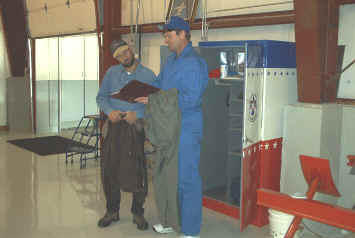 |
On January 31, 2001, I met Roy at his corporate
hangar to begin my adventure. The airplane waited invitingly outside, but first things
first. I was asked to sit down and watch a 30-minute instructional video
that described
the safety features and cockpit procedures for operating the aircraft. After viewing the
video, Roy gave me a thorough ground briefing. Here, we review some of the pertinent
information in the flight manual. The final
preparation step was to put on our flight suits! |
| After a detailed pre-flight inspection of the
exterior and interior of the airplane (and especially a cool airplane like this), it is
always mandatory to hand someone your camera and have them take a "Hero Shot" of
you. |
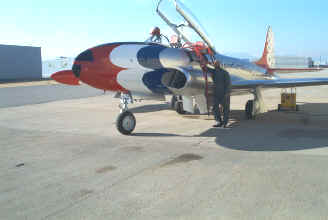 |
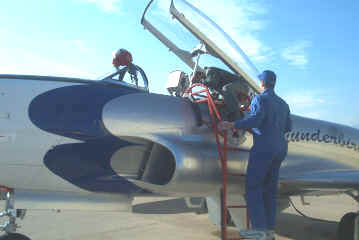 |
Roy had me climb into the back seat, then helped
me strap in. There are a lot of buckles, straps and connections to make -- among them are
the parachute harness, seatbelt and shoulder harnesses, helmet, oxygen mask, and
communication plugs. |
| The back seat of this jet is a snug place, but
then again, it was never intended to be a spacious First Class Lounge. The T-33 was a
trainer, and the back seat was the instructor's seat. It was from here that many flying
lessons (and life lessons) were taught. You can almost feel the history in the seat
cushions. |
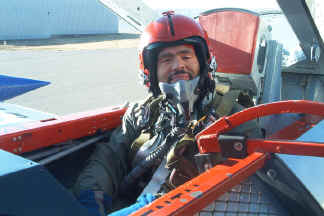 |
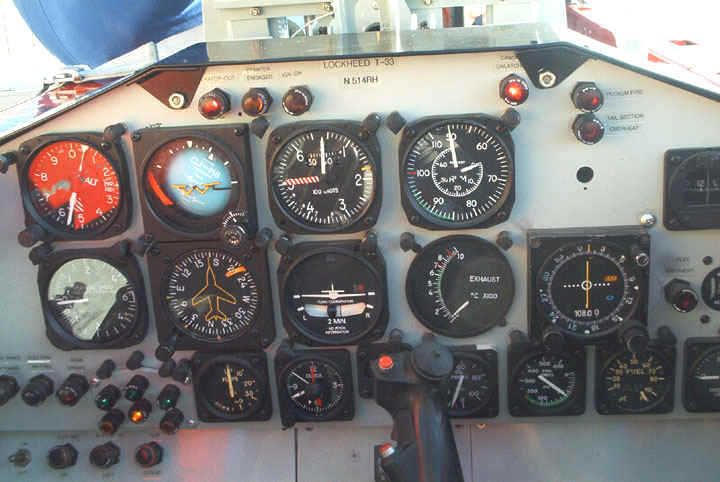 |
The preflight cockpit check begins with a test
of the oxygen system to ensure proper flow, then a check of the instruments and systems.
The back seat has a complete set of flight instruments, basic engine gauges, and status
lights which show additional information. Many of the controls for the T-33's fuel,
electrical and environmental systems, however, are located only in the front seat, so
there must be a certain element of trust between Front-Seater and Back-Seater. Time to light the fire! |
The
Automatic Terminal Information Service (ATIS) was reporting the active runways as 11L and
11R, with a light wind out of the east. The temperature was hovering just above freezing,
but with the cockpit canopy left open during taxi, it felt much colder as the icy wind
sliced right through my flight suit. However, we couldn't have asked for a more brilliant
day to drill some holes in the sky -- it was crystal blue, with a thin layer of winter
haze hovering above us at about 6500 feet thanks to a strong temperature inversion.
With no aircraft in the traffic
pattern (or even near the airport), we were cleared for takeoff on runway 11L. Prior to
brake release, the power was brought up to 80%, then 100%. The engine parameters were
checked, then the brakes were released and we lurched forward. The acceleration was
amazing. At 90 knots indicated airspeed, the nose was pulled up to 5 degrees and we lifted
off. With the landing gear retracted, we accelerated to about 120 knots until we were over
the departure end of the runway. At his point, Roy pulled the nose up into a climbing left
turn to the north as we continued to accelerate. The feeling of it all was just plain
awesome! |
|
| Our flight took us to the north of Jeffco along
the east side of the Front Range. We kept a close watch out for other traffic, and in a
matter of minutes we were near the Vance Brand Airport in Longmont, Colorado. Through the
haze we spotted a quite a few towplanes and gliders climbing out of the Boulder Municipal
Airport, some of which passed fairly close to us. We were able to spot them and maneuver
away with no problem. After clearing the Denver Class B airspace, we reached our cruising
altitude of 8500 feet and prepared to do a few maneuvers, including steep turns, high
speed climbs and descents, aileron rolls and barrel rolls. We even tried a few zero-G,
weightless pushovers! Soon, the fuel gauge told us it was time to heading back home. With
the tower's permission, we made beautiful low pass, followed by a perfect landing on
Runway 11L. |
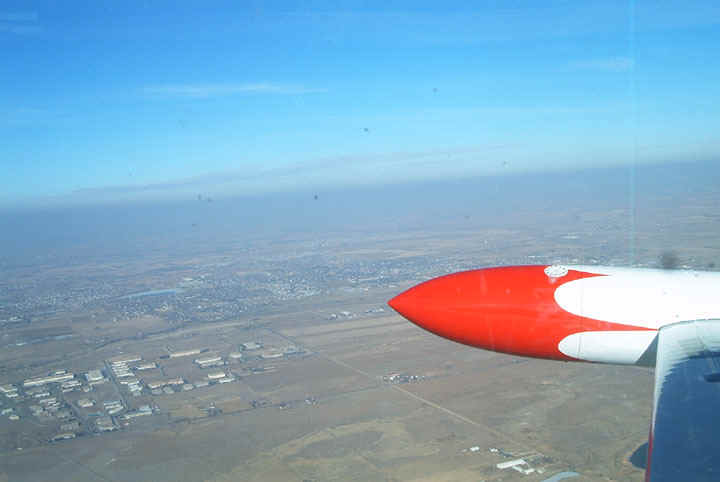 |
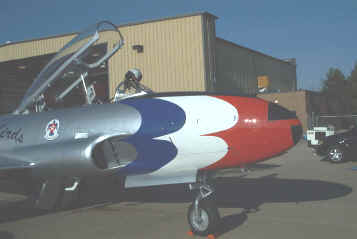 |
Here, T-33 N514RH poses in the afternoon sun
before being pushed back into its hangar after another fun day of flying. A flight like this really changes your outlook on things. The adrenaline and
excitement stay with you a long time. I consider the experience to be the most fun I've
ever had with my clothes on. |
Thanks to Gordon for his
photos and story.
If you have photos you'd like to submit,
please see our Submission Information page.

[Back to T-33 Page]
© 2003 The Doublestar Group, All Rights
Reserved
All images are used with permission of the original photographer(s).
Please respect their work by not downloading and using these images
for any purpose other than your own non-commercial enjoyment.

|